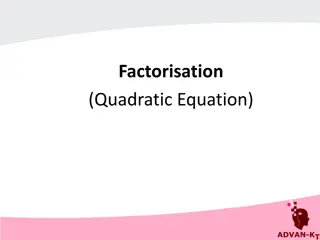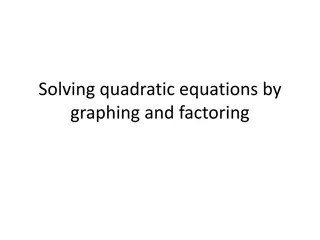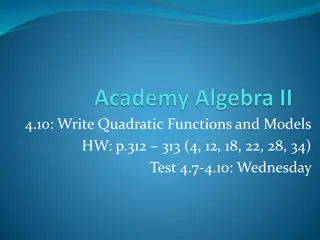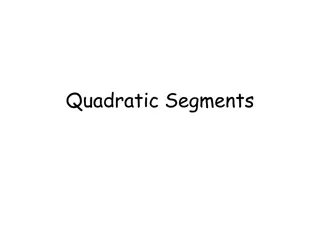Understanding Quadratic Models and Functions
Explore the application of quadratic models in analyzing and predicting data sets, learn how to identify quadratic functions through differences, and solve systems of equations using quadratic equations. Understand the vocabulary related to quadratic regression, and enhance your skills in using quadratic functions for modeling purposes.
Download Presentation

Please find below an Image/Link to download the presentation.
The content on the website is provided AS IS for your information and personal use only. It may not be sold, licensed, or shared on other websites without obtaining consent from the author. Download presentation by click this link. If you encounter any issues during the download, it is possible that the publisher has removed the file from their server.
E N D
Presentation Transcript
Warm Up Solve each system of equations. 3a + b = 5 1. a = 0, b = 5 2a 6b = 30 9a + 3b = 24 2. a = 1, b = 5 a + b = 6 4a 2b = 8 a = , b = 3 3. 2a 5b = 16
Objectives Use quadratic functions to model data. Use quadratic models to analyze and predict.
Vocabulary quadratic model quadratic regression
Recall that you can use differences to analyze patterns in data. For a set of ordered parts with equally spaced x-values, a quadratic function has constant nonzero second differences, as shown below.
Example 1A: Identifying Quadratic Data Determine whether the data set could represent a quadratic function. Explain. Find the first and second differences. x y 1 3 5 7 9 1 1 7 17 31 Equally spaced x-values Quadratic function: second differences are constant for equally spaced x- values x y 1 3 5 7 9 1 1 7 17 31 1st 2 6 10 14 2nd 4 4 4
Example 1B: Identifying Quadratic Data Determine whether the data set could represent a quadratic function. Explain. Find the first and second differences. x y 3 4 5 6 7 1 3 9 27 81 Equally spaced x-values Not a Quadratic function: second differences are not constant for equally spaced x-values x y 3 4 5 6 7 1 3 9 27 81 1st 2 6 18 54 2nd 4 12 36
Check It Out! Example 1a Determine whether the data set could represent a quadratic function. Explain. Find the first and second differences. x y 3 4 5 6 7 11 21 35 53 75 Equally spaced x-values Quadratic function: second differences are constant for equally spaced x- values x y 3 4 5 6 7 11 21 35 53 75 1st 10 14 18 22 2nd 4 4 4
Check It Out! Example 1b Determine whether the data set could represent a quadratic function. Explain. Find the first and second differences. x y 10 9 8 7 6 6 8 10 12 14 Equally spaced x-values Not a quadratic function: first differences are constant so the function is linear. x y 10 9 8 7 6 6 8 10 12 14 1st 2 22 2 2nd 0 0 0
Just as two points define a linear function, three noncollinear points define a quadratic function. You can find three coefficients a, b, and c, of f(x) = ax2 + bx + c by using a system of three equations, one for each point. The points do not need to have equally spaced x-values. Reading Math Collinear points lie on the same line. Noncollinear points do not all lie on the same line.
Example 2: Writing a Quadratic Function from Data Write a quadratic function that fits the points (1, 5), (3, 5) and (4, 16). Use each point to write a system of equations to find a, b, and c in f(x) = ax2 + bx + c. (x, y) (1, 5) f(x) = ax2 + bx + c 5 = a(1)2 + b(1)+ c System in a, b, c a + b + c = 5 1 1 9a + 3b + c = 5 (3, 5) 5 = a(3)2 + b(3)+ c 2 (4, 16) 16 = a(4)2 + b(4)+ c 16a + 4b + c = 16 3
Example 2 Continued Subtract equation by equation to get . Subtract equation by equation to get . 2 3 1 4 1 5 9a + 3b + c = 5 a + b + c = 5 16a + 4b + c = 16 a + b + c = 5 2 3 1 1 8a + 2b + 0c = 10 5 15a + 3b + 0c = 21 4
Example 2 Continued Solve equation and equation for a and b using elimination. 5 4 30a + 6b = 42 24a 6b = 30 6a + 0b = 12 5 2(15a + 3b = 21) 3(8a + 2b = 10) Multiply by 2. Multiply by 3. 4 Subtract. a = 2 Solve for a.
Example 2 Continued Substitute 2 for a into equation or equation to get b. 4 5 15(2) +3b = 21 3b = 9 8(2) +2b = 10 2b = 6 b = 3 b = 3
Example 2 Continued Substitute a = 2 and b = 3 into equation to solve for c. 1 (2) +( 3) + c = 5 1 + c = 5 c = 4 Write the function using a = 2, b = 3 and c = 4. f(x) = ax2 + bx + c f(x)= 2x2 3x 4
Example 2 Continued Check Substitute or create a table to verify that (1, 5), (3, 5), and (4, 16) satisfy the function rule.
Check It Out! Example 2 Write a quadratic function that fits the points (0, 3), (1, 0) and (2, 1). Use each point to write a system of equations to find a, b, and c in f(x) = ax2 + bx + c. (x,y) (0, 3) f(x) = ax2 + bx + c 3 = a(0)2 + b(0)+ c System in a, b, c c = 3 1 1 a + b + c = 0 (1, 0) 0 = a(1)2 + b(1)+ c 2 (2, 1) 1 = a(2)2 + b(2)+ c 4a + 2b + c = 1 3
Check It Out! Example 2 Continued Substitute c = 3 from equation into both equation and equation . 1 2 3 a + b + c = 0 a + b 3 = 0 a + b = 3 4a + 2b + c = 1 4a + 2b 3 = 1 4a + 2b = 4 3 2 4 5
Check It Out! Example 2 Continued Solve equation and equation for b using elimination. 5 4 4a + 4b = 12 (4a + 2b = 4) 4(a + b) = 4(3) 4a + 2b = 4 Multiply by 4. Subtract. 4 5 0a + 2b = 8 Solve for b. b = 4
Check It Out! Example 2 Continued Substitute 4 for b into equation or equation to find a. 4 5 a + b = 3 a + 4 = 3 a = 1 4a + 2b = 4 4a + 2(4) = 4 4 5 4a = 4 a = 1 Write the function using a = 1, b = 4, and c = 3. f(x) = ax2 + bx + c f(x)= x2 + 4x 3
Check It Out! Example 2 Continued Check Substitute or create a table to verify that (0, 3), (1, 0), and (2, 1) satisfy the function rule.
You may use any method that you studied in Chapters 3 or 4 to solve the system of three equations in three variables. For example, you can use a matrix equation as shown.
A quadratic model is a quadratic function that represents a real data set. Models are useful for making estimates. In Chapter 2, you used a graphing calculator to perform a linear regression and make predictions. You can apply a similar statistical method to make a quadratic model for a given data set using quadratic regression.
Helpful Hint The coefficient of determination R2 shows how well a quadratic function model fits the data. The closer R2 is to 1, the better the fit. In a model with R2 0.996, which is very close to 1, the quadratic model is a good fit.
Example 3: Consumer Application The table shows the cost of circular plastic wading pools based on the pool s diameter. Find a quadratic model for the cost of the pool, given its diameter. Use the model to estimate the cost of the pool with a diameter of 8 ft. 4 5 6 7 Diameter (ft) Cost $19.95 $20.25 $25.00 $34.95
Example 3 Continued Step 1 Enter the data into two lists in a graphing calculator. Step 2 Use the quadratic regression feature.
Example 3 Continued Step 3 Graph the data and function model to verify that the model fits the data. Step 4 Use the table feature to find the function value x = 8.
Example 3 Continued A quadratic model is f(x) 2.4x2 21.6x + 67.6, where x is the diameter in feet and f(x) is the cost in dollars. For a diameter of 8 ft, the model estimates a cost of about $49.54.
Check It Out! Example 3 The tables shows approximate run times for 16 mm films, given the diameter of the film on the reel. Find a quadratic model for the reel length given the diameter of the film. Use the model to estimate the reel length for an 8-inch- diameter film. Film Run Times (16 mm) Diameter (in) 5 200 7 400 9.25 600 10.5 800 12.25 1200 13.75 1600 Reel Length (ft) Run Time (min) 5.55 11.12 16.67 22.22 33.33 44.25
Check It Out! Example 4 Continued Step 1 Enter the data into two lists in a graphing calculator. Step 2 Use the quadratic regression feature.
Check It Out! Example 4 Continued Step 3 Graph the data and function model to verify that the model fits the data. Step 4 Use the table feature to find the function value x = 8.
Check It Out! Example 4 Continued A quadratic model is L(d) 14.3d2 112.4d + 430.1, where d is the diameter in inches and L(d) is the reel length. For a diameter of 8 in., the model estimates the reel length to be about 446 ft.
Lesson Quiz: Part I Determine whether each data set could represent a quadratic function. x y 5 6 7 8 9 1. not quadratic 5 8 13 21 34 x y 2 3 4 5 6 quadratic 2. 1 11 25 43 65 3. Write a quadratic function that fits the points (2, 0), (3, 2), and (5, 12). f(x) = x2 + 3x 2
Lesson Quiz: Part II 4. The table shows the prices of an ice cream cake, depending on its side. Find a quadratic model for the cost of an ice cream cake, given the diameter. Then use the model to predict the cost of an ice cream cake with a diameter of 18 in. Diameter (in.) Cost f(x) 0.011x2 + 1.43x 0.67; 6 $7.50 $21.51 10 $12.50 15 $18.50























